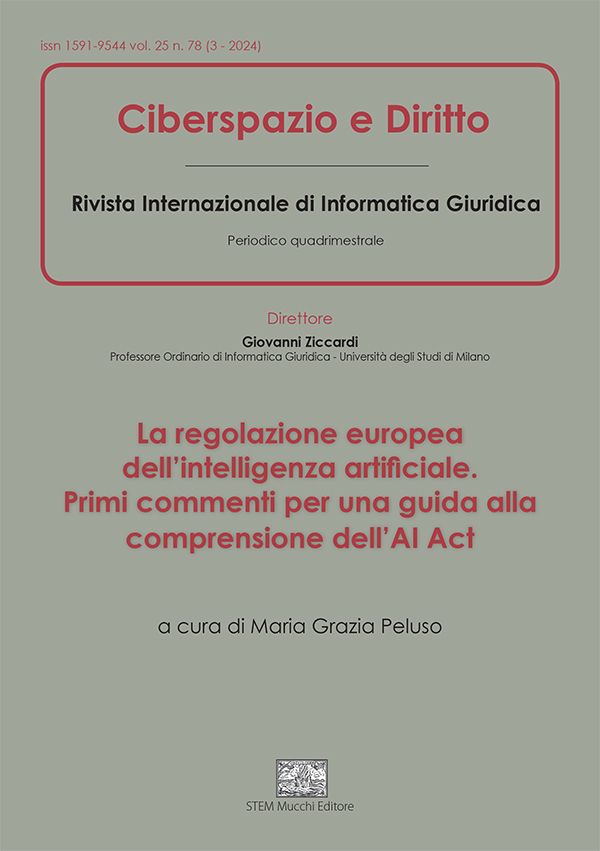L’utilizzo dell’Intelligenza Artificiale ha modificato radicalmente le relazioni sociali ed economiche e ha fatto emergere i pericoli che essa pone rispetto ai diritti fondamentali. Per questo motivo, l’UE si è preoccupata di regolamentare in maniera uniforme la materia arrivando all’adozione del Regolamento (UE) 2024/1689 che mira a implementare sistemi tecnologici affidabili. All’interno di quest’ultimo tema, il presente contributo propone allora di utilizzare la blockchain – e specificamente il modello ibrido sviluppato dall’azienda italiana “Traent Srl” – quale strumento per garantire da un punto di vista tecnico l’affidabilità e la trasparenza dell’IA. Pertanto, la Parte I fornisce innanzitutto una panoramica delle tappe principali che hanno portato il legislatore europeo all’adozione del Regolamento sull’IA. Al riguardo, particolarmente rilevante è stata la pubblicazione nel 2019 degli orientamenti etici del Gruppo di Esperti in quanto contengono un elenco di requisiti che devono essere rispettati per assicurare il rispetto delle libertà umane. Successivamente e sulla base di questi principi, l’UE ha approvato il già citato Regolamento che adotta un approccio basato sul rischio. In altri termini, i sistemi intelligenti vengono classificati in quattro grandi categorie a seconda del pericolo che essi pongono ai diritti umani e, conseguentemente, vengono imposti per ciascuna di esse una serie di diritti, requisiti tecnici e obblighi di varia natura (ad esempio, informativi, di trasparenza e di controllo). Tra questi, il presente lavoro si concentra sul diritto dell’utente ad avere una spiegazione dei processi decisionali individuali così come riconosciuto all’art. 86. La Parte II è dedicata, invece, interamente allo studio della blockchain e, in particolare, a quella proposta da Traent che è capace di sommare i vantaggi delle blockchain private (riservatezza dei dati) e pubbliche (trasparenza). Perciò, tale sezione ha l’obiettivo di dimostrare come questa nuova soluzione consenta di implementare sistemi di IA più affidabili e trasparenti. Per dimostrare tale assunto da un punto di vista non solo teorico ma anche pratico-applicativo, la Parte III del presente lavoro analizza due diversi casi d’uso – il monitoraggio delle infrastrutture pubbliche, da un lato, e il sistema sanitario, dall’altro lato – nei quali risultano evidenti i vantaggi derivanti dall’adozione della blockchain ibrida di Traent rispetto alle esigenze di sicurezza e trasparenza. Infine, la Parte IV svolge alcune considerazioni che portano quindi a concludere che la strada verso un’IA realmente rispettosa dei diritti umani sia ancora molto lunga. In questo contesto, però, la tecnologia di Traent può rappresentare sicuramente una soluzione concreta – e non solo teorica – per rendere la blockchain uno strumento effettivamente utile ad assicurare una reale implementazione del Regolamento sull’IA europeo.
The use of Artificial Intelligence has radically changed social and economic relations and brought to light the dangers it poses to fundamental rights. For this reason, the EU has been concerned to uniformly regulate the matter, leading to the adoption of Regulation (EU) 2024/1689, which aims to implement trustworthy AI systems. Within this latter topic, this contribution then proposes to use blockchain – and specifically the hybrid model developed by the Italian company “Traent Srl” – as a tool to guarantee the reliability and transparency of those technologies from a technical point of view. Therefore, Part I first provides an overview of the main steps that led the European legislator to the adoption of the AI Regulation. Particularly relevant in this regard was the publication in 2019 of the Expert Group’s Ethical Guidelines as they contain a list of requirements that must be met to ensure respect for human freedoms. Subsequently and based on these principles, the EU approved the aforementioned legislation adopting a risk-based approach. In other words, intelligent systems are classified into four broad categories according to the threat they pose to human liberties and, consequently, a series of rights, technical requirements and obligations of different nature (e.g. information, transparency and control) are imposed for each of them. Among these, this paper focuses on the user’s right to an explanation of individual decision-making processes as recognised in Art. 86. Part II is rather entirely devoted to the study of blockchain and, in particular, to the one proposed by Traent that is capable of summing up the advantages of private (data privacy) and public (transparency) blockchains. Therefore, this section aims to demonstrate how this new solution enables the implementation of more trustworthy and transparent AI systems. To demonstrate this assumption from not only a theoretical but also a practicalapplication point of view, Part III of this contribution analyses two different use cases – public infrastructure monitoring, on the one hand, and the healthcare system, on the other hand – where the advantages of adopting Traent’s hybrid blockchain are quite evident. Finally, Part IV makes some considerations to conclude that there is still a long way to go towards truly human rights-friendly AI. In this context, however, Traent’s technology can certainly represent a concrete solution – and not only a theoretical one – to make blockchain a useful tool to ensure a real implementation of the European AI Regulation.

